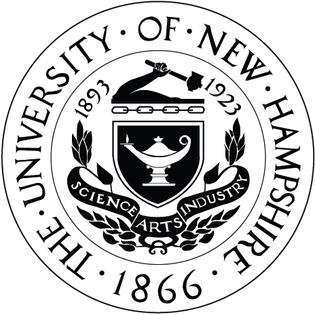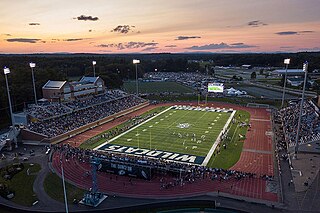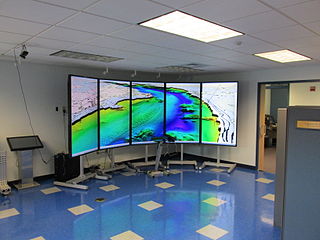
The University of New Hampshire (UNH) is a public land-grant research university with its main campus in Durham, New Hampshire. It was founded and incorporated in 1866 as a land grant college in Hanover in connection with Dartmouth College, moved to Durham in 1893, and adopted its current name in 1923.

The Seacoast Region is the southeast area of the U.S. state of New Hampshire that includes the eastern portion of Rockingham County and the southern portion of Strafford County. The region stretches 13 miles (21 km) along the Atlantic Ocean from New Hampshire's border with Salisbury, Massachusetts, to the Piscataqua River and New Hampshire's border with Kittery, Maine. The shoreline alternates between rocky and rough headlands and areas with sandy beaches. Some of the beaches are bordered by jetties or groins, particularly in the towns of Rye and Hampton. The Seacoast Region includes some inland towns as well, as far west as Epping and as far north as Rochester.

The Arnold Arboretum of Harvard University is a botanical research institution and free public park, located in the Jamaica Plain and Roslindale neighborhoods of Boston, Massachusetts. Established in 1872, it is the oldest public arboretum in North America. The landscape was designed by Charles Sprague Sargent and Frederick Law Olmsted and is the second largest "link" in the Emerald Necklace. The Arnold Arboretum's collection of temperate trees, shrubs, and vines has a particular emphasis on the plants of the eastern United States and eastern Asia, where arboretum staff and colleagues are actively sourcing new material on plant collecting expeditions. The arboretum supports research in its landscape and in its Weld Hill Research Building.
The Mizzou Botanic Garden contains thousands of plants within the campus of the University of Missouri in Columbia, Missouri, United States. The Garden includes famous icons, such as Thomas Jefferson's original grave marker and the Columns of Academic Hall, and is open year-round, only asking for a small donation to visit.

Whittemore Center Arena, known colloquially as The Whitt, is a multi-purpose arena in Durham, New Hampshire, United States, on the campus of the University of New Hampshire. It was built for $30 million and opened in November 1995. It was dedicated to Frederick B. Whittemore and his family on May 5, 1996. It is adjacent to its predecessor, Snively Arena, which is still standing and is used as a recreation facility. It is also adjacent to Durham's Amtrak station, and it is across the street from Wildcat Stadium.

The University of New Hampshire at Manchester is the urban campus of the public University of New Hampshire and is located in Manchester, New Hampshire. It was established in 1985 as the sixth college of the University of New Hampshire.

Durham–University of New Hampshire station, also known as Durham–UNH station or simply Durham station, is a passenger rail station in Durham, New Hampshire, served by Amtrak's Downeaster line. The historic depot, which now houses the UNH Dairy Bar, is situated just west of downtown Durham on the campus of the University of New Hampshire (UNH). The station is owned by the university, but an adjacent parking area is managed by the town of Durham. On average, about 161 rail passengers board or detrain daily at Durham, making it the third-busiest Amtrak stop in New Hampshire.

Willowwood Arboretum, 131 acres (53 ha), is an arboretum and public park located at 300 Longview Road, Chester Township, New Jersey, Morris County, New Jersey. It is part of the Morris County Park System and is open to the public daily.

Wildcat Stadium is an 11,015-seat open-air multi-purpose stadium in Durham, New Hampshire, on the campus of the University of New Hampshire (UNH). It is home to the New Hampshire Wildcats football, lacrosse and track and field varsity teams. The stadium, which runs west-northwest, consists of a FieldTurf playing surface surrounded by a 400-metre track. On either side of the track are aluminum stands. The stadium lies just southwest of the Field House, which houses Lundholm Gym as well as Swazey Pool and the Jerry Azumah Performance Center.

Rutgers Gardens is the official botanic garden of Rutgers University, located on the outskirts of Cook Campus, at 112 Ryders Lane, North Brunswick, New Jersey. The grounds include 60 acres of designed beds, specialty gardens, tree and shrub collections, lawns, and walking paths, as well as the adjoining 70-acre Frank G. Helyar Woods. A place of learning and beauty, Rutgers Gardens strives to provide a fun, educational, and engaging place for students, faculty, and the community to enjoy the natural world. The gardens are open year-round, without fee, and feature horticultural collections arranged in garden settings. In 2017 it was granted landmark status by the American Society for Horticultural Science.

The University of Wisconsin–Madison Arboretum is a teaching and research facility of the University of Wisconsin–Madison and the site of historic research in ecological restoration. In addition to its 1,260 acres (5 km2) in Madison, Wisconsin, the Arboretum also manages 520 acres (210 ha) of remnant forests and prairies throughout Wisconsin. It was designated a National Historic Landmark in 2021, in recognition for its role as a pioneer in the field of ecological restoration.

The University of Guelph Arboretum is an arboretum that was formally established in 1970 by the University of Guelph. The Arboretum's objective is to “connect people with nature and enhance teaching, research, and outreach at the University”, and to “serve as an “outdoor learning resource,” a “living laboratory” and a “community resource”. The Arboretum is open all year round to the public from dawn to dusk. It is used for a wide array of purposes such as teaching, research, conservation, recreation, school programs, adult workshops, and pre-registered group walking tours. It is also a popular place for weddings, dinner theatre, or memorial services and dedications. There are more than 40 collections of woody plants for academic and display purposes, as well as various display gardens, memorial plantings, and facilities. The Arboretum and University of Guelph sit on Dish with One Spoon territory, treaty lands of the Mississaugas of the Credit, and the Between the Lakes Treaty 3 lands. Continuing to care for the rich natural heritage of this land in a sustainable manner is part of the Arboretum’s vision
WUNH is a non-commercial college radio station at the University of New Hampshire, in Durham, New Hampshire. The station broadcasts alternative music, sports, and more to the community and surrounding area on 6000 watts.

The Lynn R. Lowrey Arboretum is an arboretum located throughout the campus of Rice University in Houston, Texas, United States. It is open daily without charge.

The Orland E. White Arboretum, also known as the State Arboretum of Virginia, is an arboretum operated by the University of Virginia as part of the Blandy Experimental Farm. It is located at 400 Blandy Farm Lane, Boyce, Virginia, and open to visitors daily from dawn to dusk without fee.

The Center for Coastal & Ocean Mapping (CCOM) / NOAA-UNH Joint Hydrographic Center (JHC) was founded in 2000 by Dr. Larry Mayer to find ways to process the massive amounts of data coming from sonar systems at rates commensurate with data collection; that is, to make the data ready for chart production as rapidly as the data could be collected.
John Caspar Wister was one of the United States' most highly honored horticulturists.
Isabella Preston was a horticulturist and public servant widely recognized for her achievements in plant hybridization and extensive work in ornamental plant breeding. During her 26-year career, she produced nearly 200 new hardy hybrids of lily, lilac, crab apple, iris and rose plants for Canada's cold climate. While female plant breeders were rather rare in her day, she quietly challenged gender bias and set the stage for new generations of breeding programs at the Central Experimental Farm in Ottawa, Ontario, Canada and elsewhere.
Susan Adams Delano McKelvey (1883-1964) was an American botanist and author, noted for her work at the Arnold Arboretum. The standard author abbreviation McKelvey is used to indicate this person as the author when citing a botanical name.

Elwyn Marshall Meader was an American botanist and plant scientist. Over the course of his career, Meader developed over 50 new strains of plum, peach, squash, rutabaga, sweet corn, melon, watermelon, salad bean, pod bean, pepper, pumpkin, nectarine, bush cherry, kiwi fruit, persimmon, cranberry, raspberry, and blueberry. He developed the Miss Kim Lilac from seeds of a wild lilac bush he found in the mountains of Korea and decided to name it after "all the Miss Kims in Korea".















